Plastic sewer pipes: how to choose the size and type of
The system of sewage disposal from an apartment or a country house is perhaps the most important engineering network in a dwelling. For its arrangement most often used plastic sewer pipes. The quality and durability of the drain system depends on the type of polymer you choose and how correctly you select the diameter of the products.
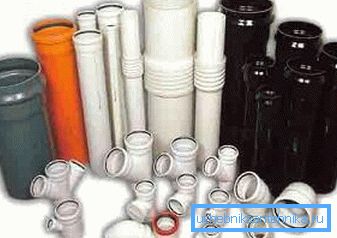
Varieties of plastic pipes for the arrangement of sewage
Details for installation of a sewer network are made of various polymers, technical characteristics and which operational properties can differ from each other considerably.
Consider in more detail the types - characteristics - plastic sewer pipes.
Polyvinyl chloride (PVC)
Products from this type of plastic are most often used for the manufacture of sewage systems.
This is due to the following qualities:
- PVC parts are resistant to various aggressive substances - acids, mineral oils, alkalis, which are often sewage;
- material does not sustain combustion, however, at temperatures above + 120 degrees Celsius it decomposes into components, releasing a harmful substance into the atmosphere - a compound of chlorine with hydrogen;
- polyvinyl chloride are not a conductor, because sewage does not require grounding;
- PVC belongs to the category of non-plasticized polymers, therefore at strong blow it can collapse;
- the material can not be used for the arrangement of sewage, which is planned to transport hot liquid (for example, from a washing machine or dishwasher).
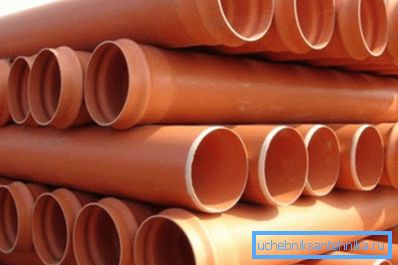
Note! Polyvinyl chloride sewers must be installed free of stress. For arrangement of turns or bends, you should use the required number of fittings or bends for pipes.
Polypropylene
This polymer is universal. From it produce parts for water transport systems for various purposes, including the arrangement of storm drains.
Here are the features of polypropylene:
- plastic pipes for sewage of this type of polymer have the lowest weight;
- have increased strength, therefore they are recommended for installation of systems transporting fluid with a lot of abrasive particles;
- this type of plastic softens only at 140 degrees Celsius, because even boiling water will not cause sewage harm;
- The material is well tolerated by potent chemicals (with the exception of concentrated acid).

Polyethylene
Such plastic parts are widely used for the installation of both internal and external sewage.
They have many undeniable advantages:
- have the increased durability to influence of external aggressive environment;
- able to maintain plasticity and strength at low ambient temperature (when freezing sewage does not break plastic, and after thawing, the part returns to its original dimensions);
- the inner surface of polyethylene pipes is distinguished by increased smoothness and slippery properties, which is why they very rarely cause traffic jams and blockages;
- products of low and high pressure polyethylene do not withstand the transport of liquids with high temperatures (the maximum value of this indicator is + 80 degrees Celsius).
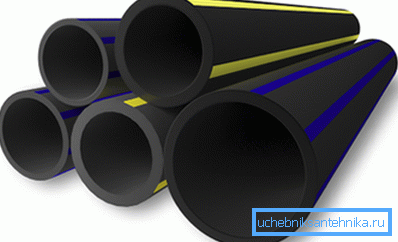
Sizes of parts for mounting the drain system
In addition to the material, it is necessary to choose the correct diameters of sewer plastic pipes. This value depends on the number and type of sanitary appliances and kitchen equipment that are connected to the drain system.
Tip! As a rule, the optimal size of vertical risers and trunk systems does not exceed 110 mm, and the diameter of the pipes from the sinks and the bathroom is 40-50 mm. In some specific cases, a 75 mm plastic sewer pipe is used (for example, when connecting a dishwasher or washing machine).
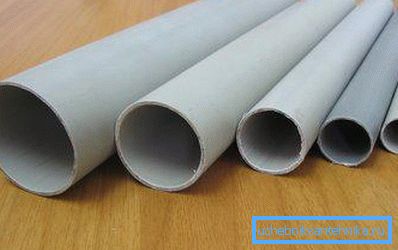
If you decide to design a drainage system with your own hands, then you should choose the dimensions of plastic pipes for sewage taking into account such moments:
- A wide detail is necessary for a toilet bowl. This is due to the fact that at the time of discharge you need to dispose of a large amount of water. In addition, solid objects often fall into the toilet, which can clog a small pipe.
- As for the bathroom, here the diameter of plastic pipes for sewage can be smaller. Despite the fact that water is also a lot, it enters the sewer system gradually. This is due to the small diameter of the drain hole.
- The toilet and bidet can be connected to the same drain section with a diameter of 100 or 110 mm. Both devices require the removal of a large amount of wastewater, but they are unlikely to ever be used together for a long time. Because to increase the size of plastic sewer pipes in this case does not make sense.
- Instructions for the design of sewage states that the diameter of parts for the engineering network should be chosen so that when transporting water, the pipe is not completely filled, leaving little space for air. Otherwise, hydraulic valves that are in the drain siphons may break. This will cause an unpleasant smell in the room.
- Materials, dimensions and other main points that need to be considered in the manufacture of sewage systems are governed by SNiP 2.04.01-85.
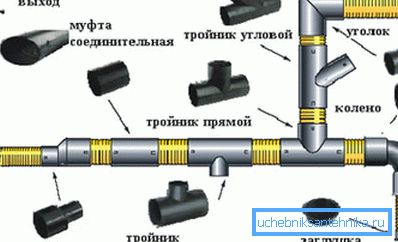
Information on what should be sewer plastic pipes according to GOST presented in the table.
| Outside diameter | Wall thickness | ||
| Value | Tolerance | Value | Tolerance |
| 1200 | 2 | 29.4 | 3.2 |
| 1000 | 1.6 | 24.5 | 2.7 |
| 800 | 1,3 | 19.6 | 2.2 |
| 630 | 1.1 | 15.4 | 1.8 |
| 500 | 0.9 | 12.3 | 1.5 |
| 400 | 0.7 | 9.8 | 1.2 |
| 315 | 0.6 | 7.7 | one |
| 250 | 0.5 | 6.2 | 0.9 |
| 200 | 0.5 | 4.9 | 0.7 |
| 160 | 0.4 | four | 0.6 |
| 125 | 0.3 | 3.2 | 0.6 |
| 110 | 0.3 | 2.7 | 0.5 |
| 90 | 0.3 | 2.2 | 0.5 |
| 75 | 0.3 | 1.9 | 0.4 |
| 63 | 0.2 | 1.6 | 0.4 |
| 50 | 0.2 | 1,3 | 0.4 |
Note! Unlike cast iron pipes, organic and inorganic waste does not form inside plastic pipes. Therefore, when upgrading the old sewer, you can use parts of smaller diameter than those that were installed earlier. This is important for those who are concerned about the question of how much a sewage plastic pipe costs. After all, the price depends on the size.
Installation Tips
In order for the sewage system to work properly and for a long time, the following recommendations should be followed when assembling the pipeline:
- parts must be positioned so that the sockets are directed towards the flow of the transported water;
- before docking the elements, the ends should be thoroughly cleaned from dust and dirt;
- Before inserting the parts into each other, make sure that the sealing ring is in the proper place;
- inserting the end of the pipe into the socket, it is necessary to make a mark that will fix the depth of the occurrence of parts into each other;
- during the final installation, the pipe must be pulled back about 1 cm (this will protect the finished system from distortion as a result of the temperature linear expansion of the parts used);
- To ensure tightness and ease of installation, you can use a silicone sealant that is applied to a smooth part (in no case in the socket).

Conclusion
Choosing the right size products, you should take care of their quality installation. After all, no matter how good the material, if improperly docked, the wastewater disposal system will still not be tight. For more information, you can learn from the video in this article.